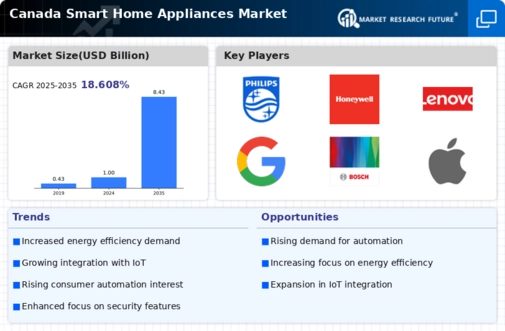The smart home-appliances market in Canada is characterized by a dynamic competitive landscape, driven by technological advancements and evolving consumer preferences. Major players such as Amazon (US), Google (US), and Samsung (KR) are at the forefront, each adopting distinct strategies to enhance their market presence. Amazon (US) focuses on integrating its Alexa platform into various devices, thereby fostering a seamless ecosystem that encourages consumer loyalty. Google (US), on the other hand, emphasizes AI-driven solutions, enhancing user experience through smart home integration. Samsung (KR) leverages its extensive product portfolio, aiming for innovation in connectivity and energy efficiency, which positions it favorably in a market increasingly concerned with sustainability.
The business tactics employed by these companies reflect a concerted effort to optimize operations and adapt to local market conditions. Localizing manufacturing and enhancing supply chain efficiency are prevalent strategies, allowing for quicker response times to consumer demands. The market structure appears moderately fragmented, with a mix of established brands and emerging players, yet the influence of key players remains substantial, shaping consumer expectations and driving technological advancements.
In October 2025, Amazon (US) announced a partnership with a leading Canadian energy provider to develop smart energy management solutions. This strategic move is likely to enhance Amazon's foothold in the energy-efficient appliance segment, aligning with growing consumer interest in sustainability. By integrating energy management features into its smart home devices, Amazon (US) not only addresses environmental concerns but also positions itself as a leader in the smart energy space.
In September 2025, Google (US) unveiled its latest line of smart home devices, featuring advanced AI capabilities that allow for predictive learning based on user behavior. This innovation is indicative of Google's commitment to enhancing user experience through technology. By focusing on AI integration, Google (US) aims to differentiate its offerings in a crowded market, potentially increasing its market share as consumers seek more intuitive solutions.
In August 2025, Samsung (KR) launched a new initiative aimed at improving interoperability among its smart home devices. This initiative is crucial as it addresses a common consumer pain point regarding compatibility across different brands. By fostering a more cohesive ecosystem, Samsung (KR) not only enhances user satisfaction but also strengthens its competitive position against rivals who may not prioritize such integration.
As of November 2025, the competitive trends in the smart home-appliances market are increasingly defined by digitalization, sustainability, and AI integration. Strategic alliances are becoming more prevalent, as companies recognize the value of collaboration in enhancing product offerings and market reach. Looking ahead, competitive differentiation is likely to evolve, shifting from price-based competition to a focus on innovation, technological advancement, and supply chain reliability. This transition suggests that companies that prioritize these aspects will be better positioned to capture market share and meet the demands of a discerning consumer base.























Leave a Comment